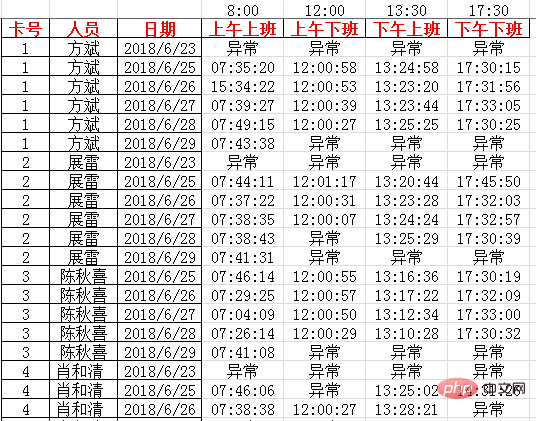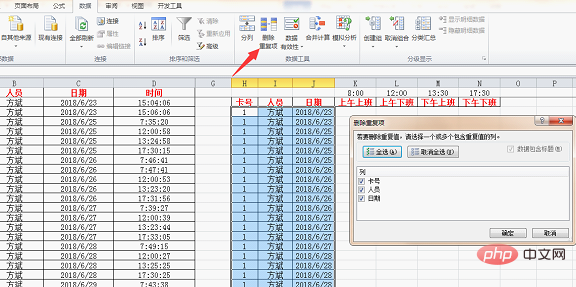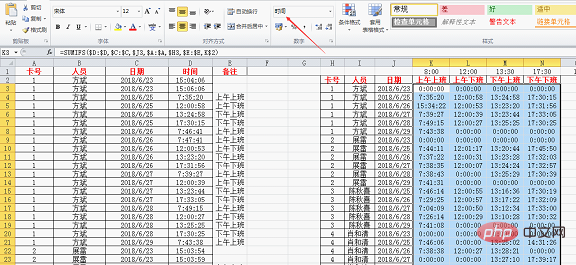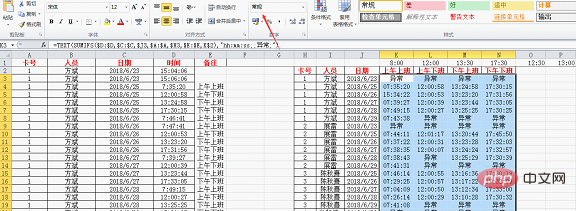Sharing practical Excel skills: quickly organize attendance data!
In the previous article "Excel Chart Learning: Creating Multi-Series Multi-Conditional Histograms with Target Values", we learned about an Excel chart tutorial, and today we share an article on organizing attendance data The tutorial is just two simple formulas. Once you learn it, you will not be afraid no matter how many people there are in your company.

Attendance machines are used by almost every company, and at the beginning and end of each month, it takes us a lot of time to sort out the attendance data exported by the machine. Today we will teach you With two formulas, you can sort out the attendance data in one minute.
The attendance data we usually export from the attendance machine is basically in the following format when opened through Excel:

In order to further collect attendance data, we hope to The above format is organized into the following effect:

Every person’s daily punch-in record is recorded on the same line, and abnormalities are marked after comparison according to the commuting time.
The working hours are as follows:
The morning working time is 8:00, the morning working time is 12:00, the afternoon working time is 13:30, and the afternoon working time is 17:30
To achieve this kind of effect conversion, it feels like a very troublesome thing. In fact, as long as you master two formulas and some basic operating skills, it can be completed in one minute. Let’s take a look at how to achieve it.
1. Basic data sorting
#Add a few columns to the right of the basic data and divide the time into morning work, morning get off work, and afternoon work and afternoon off work, and mark the corresponding time:

Copy the three columns of card number, person and date to the corresponding positions on the right, and then use "Delete Duplicates" Function:

After clicking OK, duplicate content will be deleted, and only one line will be retained per person per day:

Next The task is to fill in the corresponding punch-in time into the corresponding position, and do not display the specific time for abnormal data, only display the word "abnormal". In order to achieve this purpose, two formulas need to be used. Let’s look at the first formula first.
2. Use the formula to remark the clock-in time
In order to facilitate the statistics of the clock-in time, you must first make notes based on the commuting time, and implement the following The effect in the picture:

It is divided into four situations according to the commuting time:
1. Checking in before 8 o'clock is regarded as working in the morning;
2. Checking in after 12 o'clock is considered as leaving work in the morning. Considering that there is still work in the afternoon, it is artificially stipulated that checking in between 12:00 and 12:30 is considered leaving work in the morning;
3. Similarly, It is artificially stipulated that clocking in between 13:00 and 13:30 means going to work in the afternoon;
4. Clocking in after 17:30 means going to get off work in the afternoon;
5. Clocking in at other times is invalid. , displays blank.
The formula in cell E2 is:
=IF(D2=$L$1,D2< ;=$O$1),$L$2,"")&IF(AND(D2>=$P$1,D2=$N$1,$ N$2,""), double-click to fill to achieve the effect in the picture.
The first IF is : =IF(D2
When d2( When the clock-in time) is less than or equal to k1 (morning work time), the result of the if function is k2 (the four words "morning work time"), otherwise a null value is returned;
The second if is :IF(AND(D2>=$L$1,D2

When d2 (Punch-in time) is greater than or equal to L2 (morning off-duty time) and less than or equal to o1 (artificially specified punch-in deadline), the result of the if function is L2 (the four words "off-duty in the morning"), otherwise a null value is returned.
The third if is : IF(AND(D2>=$P$1,D2

When d2 (punch time) is greater than or equal to p2 (artificially specified start time of clocking in to work) and less than or equal to M1 (afternoon work time), the result of the if function is M2 (the four words "off work in the afternoon"), otherwise a null value is returned .
The fourth if is : IF(D2>=$N$1,$N$2,"")
When d2 (check in time) is greater than or equal to N1 (afternoon off-duty time), the result of the if function is N2 (the four words "off-duty in the afternoon"), otherwise a null value is returned.
After completing the remark information, it is time to fill in the corresponding time in the corresponding area. At this time, you can use a formula to right-click and pull down to complete the time filling. Let's take a look at which magical formula it is. Bar.
3. Filling time
Enter the formula in cell K2:
=TEXT(SUMIFS($ D:$D,$C:$C,$J3,$A:$A,$H3,$E:$E,K$2),"hh:mm:ss;;Exception;")
Pull down to the right to complete the time filling.

This formula uses two functions, text and sumifs. Let’s take a look at the principle of the formula.
The structure of the sumifs function is sumifs (data area required to be summed, condition area 1, condition 1, condition area 2, condition 2...) , in today's example we used The actual sum of the three conditions is column D. The three conditions are date, card number and remark information. The numbers that meet the three conditions are all unique, so the summation result and the reference result are consistent.
So the formula is:
SUMIFS($D:$D,$C:$C,$J3,$A:$A,$H3,$E:$E ,K$2)

Use the formula to get the result to be some numbers, because in Excel, the essence of date and time are numbers, and integers represent dates. Decimals represent time. Change the cell format in the above area to time and see the effect. The numbers become specific times, as shown below:

In fact After setting the cell format, we have basically achieved the goal. In order to improve the display effect and force the display to be in time format, we added a text function outside sumifs. Even in the regular format, it is displayed according to time. At the same time, the location of 0 is displayed as abnormal.

Briefly explain the usage of text, text (data, specified format), in this example, the second parameter format is defined as the display mode of hours, minutes and seconds, the letter h , m and s respectively represent hours, minutes and seconds, both of which are displayed with two digits.
The semicolon in the format code can set the display mode separately according to the data type. text specifies that the data is divided into four types: positive number; negative number; zero; text. In this example, positive numbers are displayed according to the time format, negative numbers and text are not displayed without a specified format, and zero is displayed as the word "abnormal".
Regarding the text function, today you just need to understand its usage in this example.
Summary:
1. Reasonable use of auxiliary columns: The organization of attendance data has always been a troublesome problem, and it is often very difficult to get it right in one step. , at this time, reasonable use of auxiliary columns can reduce the difficulty of the problem a lot.
2. The formula is not omnipotent: the basic data of attendance is time, and related regulations together form the logical relationship between the data. This example is suitable for more standardized situations, if multiple shifts coexist. In this case, it cannot be achieved by this method. It must also be comprehensively considered based on the commuting time corresponding to each person's shift, and the supporting software of the attendance machine is needed to complete the statistical summary of the data.
Related learning recommendations: excel tutorial
The above is the detailed content of Sharing practical Excel skills: quickly organize attendance data!. For more information, please follow other related articles on the PHP Chinese website!

Hot AI Tools

Undresser.AI Undress
AI-powered app for creating realistic nude photos

AI Clothes Remover
Online AI tool for removing clothes from photos.

Undress AI Tool
Undress images for free

Clothoff.io
AI clothes remover

AI Hentai Generator
Generate AI Hentai for free.

Hot Article

Hot Tools

Notepad++7.3.1
Easy-to-use and free code editor

SublimeText3 Chinese version
Chinese version, very easy to use

Zend Studio 13.0.1
Powerful PHP integrated development environment

Dreamweaver CS6
Visual web development tools

SublimeText3 Mac version
God-level code editing software (SublimeText3)

Hot Topics
 1377
1377
 52
52
 What should I do if the frame line disappears when printing in Excel?
Mar 21, 2024 am 09:50 AM
What should I do if the frame line disappears when printing in Excel?
Mar 21, 2024 am 09:50 AM
If when opening a file that needs to be printed, we will find that the table frame line has disappeared for some reason in the print preview. When encountering such a situation, we must deal with it in time. If this also appears in your print file If you have questions like this, then join the editor to learn the following course: What should I do if the frame line disappears when printing a table in Excel? 1. Open a file that needs to be printed, as shown in the figure below. 2. Select all required content areas, as shown in the figure below. 3. Right-click the mouse and select the "Format Cells" option, as shown in the figure below. 4. Click the “Border” option at the top of the window, as shown in the figure below. 5. Select the thin solid line pattern in the line style on the left, as shown in the figure below. 6. Select "Outer Border"
 How to filter more than 3 keywords at the same time in excel
Mar 21, 2024 pm 03:16 PM
How to filter more than 3 keywords at the same time in excel
Mar 21, 2024 pm 03:16 PM
Excel is often used to process data in daily office work, and it is often necessary to use the "filter" function. When we choose to perform "filtering" in Excel, we can only filter up to two conditions for the same column. So, do you know how to filter more than 3 keywords at the same time in Excel? Next, let me demonstrate it to you. The first method is to gradually add the conditions to the filter. If you want to filter out three qualifying details at the same time, you first need to filter out one of them step by step. At the beginning, you can first filter out employees with the surname "Wang" based on the conditions. Then click [OK], and then check [Add current selection to filter] in the filter results. The steps are as follows. Similarly, perform filtering separately again
 How to change excel table compatibility mode to normal mode
Mar 20, 2024 pm 08:01 PM
How to change excel table compatibility mode to normal mode
Mar 20, 2024 pm 08:01 PM
In our daily work and study, we copy Excel files from others, open them to add content or re-edit them, and then save them. Sometimes a compatibility check dialog box will appear, which is very troublesome. I don’t know Excel software. , can it be changed to normal mode? So below, the editor will bring you detailed steps to solve this problem, let us learn together. Finally, be sure to remember to save it. 1. Open a worksheet and display an additional compatibility mode in the name of the worksheet, as shown in the figure. 2. In this worksheet, after modifying the content and saving it, the dialog box of the compatibility checker always pops up. It is very troublesome to see this page, as shown in the figure. 3. Click the Office button, click Save As, and then
 How to type subscript in excel
Mar 20, 2024 am 11:31 AM
How to type subscript in excel
Mar 20, 2024 am 11:31 AM
eWe often use Excel to make some data tables and the like. Sometimes when entering parameter values, we need to superscript or subscript a certain number. For example, mathematical formulas are often used. So how do you type the subscript in Excel? ?Let’s take a look at the detailed steps: 1. Superscript method: 1. First, enter a3 (3 is superscript) in Excel. 2. Select the number "3", right-click and select "Format Cells". 3. Click "Superscript" and then "OK". 4. Look, the effect is like this. 2. Subscript method: 1. Similar to the superscript setting method, enter "ln310" (3 is the subscript) in the cell, select the number "3", right-click and select "Format Cells". 2. Check "Subscript" and click "OK"
 How to set superscript in excel
Mar 20, 2024 pm 04:30 PM
How to set superscript in excel
Mar 20, 2024 pm 04:30 PM
When processing data, sometimes we encounter data that contains various symbols such as multiples, temperatures, etc. Do you know how to set superscripts in Excel? When we use Excel to process data, if we do not set superscripts, it will make it more troublesome to enter a lot of our data. Today, the editor will bring you the specific setting method of excel superscript. 1. First, let us open the Microsoft Office Excel document on the desktop and select the text that needs to be modified into superscript, as shown in the figure. 2. Then, right-click and select the "Format Cells" option in the menu that appears after clicking, as shown in the figure. 3. Next, in the “Format Cells” dialog box that pops up automatically
 How to use the iif function in excel
Mar 20, 2024 pm 06:10 PM
How to use the iif function in excel
Mar 20, 2024 pm 06:10 PM
Most users use Excel to process table data. In fact, Excel also has a VBA program. Apart from experts, not many users have used this function. The iif function is often used when writing in VBA. It is actually the same as if The functions of the functions are similar. Let me introduce to you the usage of the iif function. There are iif functions in SQL statements and VBA code in Excel. The iif function is similar to the IF function in the excel worksheet. It performs true and false value judgment and returns different results based on the logically calculated true and false values. IF function usage is (condition, yes, no). IF statement and IIF function in VBA. The former IF statement is a control statement that can execute different statements according to conditions. The latter
 Where to set excel reading mode
Mar 21, 2024 am 08:40 AM
Where to set excel reading mode
Mar 21, 2024 am 08:40 AM
In the study of software, we are accustomed to using excel, not only because it is convenient, but also because it can meet a variety of formats needed in actual work, and excel is very flexible to use, and there is a mode that is convenient for reading. Today I brought For everyone: where to set the excel reading mode. 1. Turn on the computer, then open the Excel application and find the target data. 2. There are two ways to set the reading mode in Excel. The first one: In Excel, there are a large number of convenient processing methods distributed in the Excel layout. In the lower right corner of Excel, there is a shortcut to set the reading mode. Find the pattern of the cross mark and click it to enter the reading mode. There is a small three-dimensional mark on the right side of the cross mark.
 How to insert excel icons into PPT slides
Mar 26, 2024 pm 05:40 PM
How to insert excel icons into PPT slides
Mar 26, 2024 pm 05:40 PM
1. Open the PPT and turn the page to the page where you need to insert the excel icon. Click the Insert tab. 2. Click [Object]. 3. The following dialog box will pop up. 4. Click [Create from file] and click [Browse]. 5. Select the excel table to be inserted. 6. Click OK and the following page will pop up. 7. Check [Show as icon]. 8. Click OK.




